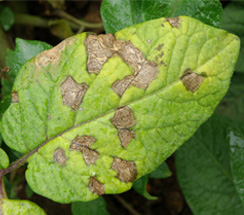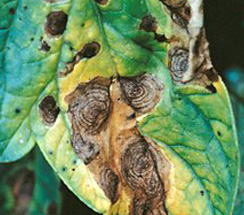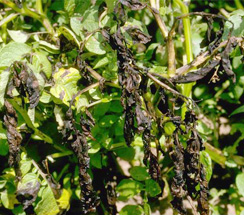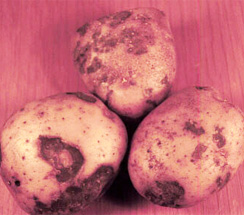| Early blight: Alternaria solani |
Symptom:
- It is present in both hills & plains.
- Brown-black necrotic spot-angular, oval shape characterized by concentric rings.
- Several spot coalesce & spread all over the leaf.
- Shot holes on fruits.
|
| |
 |
 |
 |
 |
| |
Angular spot on leaf |
Concentric rings |
Infected crop |
Shot holes in tuber |
|
Identification of pathogen:
Mode of spread and survival:
- The conidia and the mycelium in the soil or in the debris of the affected plants can remain viable for more than 17 months.
- These conidia or the new conidia found on the overwintered mycelium bring about the primary infection of the succeeding potato crop.
- Secondary infection is more important in the spread of the disease.
- The conidia formed on the spots developed due to primary infection are disseminated by wind to long distances.
- The conidia from the affected plant may also be disseminated to the adjoining plants by rain and insects.
Epidemiology:
- Dry warm weather with intermittent rain.
- Poor vigor. Temperature: 25-30°C.
- Poorly manured crop.
|
Management:
- Disease free seed tubers should be used for planting.
- Removal and destruction of infected plant debris should be done because the spores lying in the soil are the primary source of infection.
- Very early spraying with Zineb or captan 0.2% and repeating it for every 15 – 20 days gives effective control.
- The variety Kufri Sindhuri possesses a fair degree of resistance.
|
Source of Images:
https://www.agric.wa.gov.au/sites/gateway/files/alternaria%20%2824%29.JPG
http://www.apsnet.org/edcenter/intropp/lessons/fungi/ascomycetes/PublishingImages/PotatoTomato01sm.jpg
http://www.forestryimages.org/browse/detail.cfm?imgnum=5362500
http://agropedia.iitk.ac.in/sites/default/files/Early%20blight%20_potato.jpg |




